We've done several hundred hours of multivariate testing (think: test record) in 2023 and have come several conclusions. One of them is: you aren't measuring what you THINK you are measuring!I have almost all the test records ever made, and yes there’s no way they’re all “the same”. I’m coming around to your (and Wally’s, RIP) way of thinking, that if it can be accurately assessed in physical terms, without a record, and it can be corrected using physical methods, do it that way first.
Using Wally Tools
- Thread starter tima
- Start date
You are using an out of date browser. It may not display this or other websites correctly.
You should upgrade or use an alternative browser.
You should upgrade or use an alternative browser.
By the way - and as a reminder - as a WallyTools owner, you have pretty much 7 days a week access to my support as well. Reach out to me if you have any analog issue. I certainly am not an expert on ALL vinyl playback matters, but I'll let you know when you've hit my limit of comfort in any given area.I have almost all the test records ever made, and yes there’s no way they’re all “the same”. I’m coming around to your (and Wally’s, RIP) way of thinking, that if it can be accurately assessed in physical terms, without a record, and it can be corrected using physical methods, do it that way first.
We've done several hundred hours of multivariate testing (think: test record) in 2023 and have come several conclusions. One of them is: you aren't measuring what you THINK you are measuring!
Interesting. Can you expand on that with some simple examples? Tia
I will be doing a video on this in the near future. This "mistaken measurement" issue is true to greater or lesser degrees with all setup parameters and is why relying upon a test record for all setup parameters makes it such an iterative approach where improvements can certainly be made but optimization is not knowable.Interesting. Can you expand on that with some simple examples? Tia
Measuring torque force by test record is the biggest offender since the test is measuring changes to stylus, coil and cantilever orientation as a result of out of control torque forces in the tonearm. You can very easily get lowest distortion figures with the arm under sub-optimal torque forces (from bearing friction, too much anti-skate or not enough anti-skate) by aligning the stylus properly yet still have the damper VERY asymmetrically compressed. We have found no evidence whatsoever that an asymmetrically compressed damper throws off a characteristic waveform behavior, yet the audibility of a relaxed damper is dead obvious to anyone who will take the time to do a proper trial with a WallySkater.
It is a shame that it is not measurable, but then so much of what we can easily empirically experience in our hobby is not known to be measurable - YET. What is the electrical characteristic of increased "resolution"? We all have experienced it for ourselves, but what does it look like on test gear? I'd say the person who may be closest to an answer may be Garth Powell, but how can we know that, say, "resolution" isn't just a second or third order function of whatever is being measured?
So many questions...
I recall someone in this thread asking about a Wally Scope. Saw a brand new in box one for $1000 off at the link below. It’s not my listing, just wanted to pass it along:Yes, before I bought the Wally Tools and in particular the Wally Scope, I also tried in vain with a Dinolite USB Microscope and then importing the photo into standard image software to draw the lines and determine the VTA and SRA angles by hand.

Wally Scope NIB Never Used (SAVE BIG!)
This is a must have for any turntable owner. Absolutely legendary and hard to find in stock.Brand new, never used!Can upgrade to v2 with a kit directly from Wally for $190.Wally price for v2 is $1500 USD + shipping (USD 85 to Toronto) + HST = ~$2500.And there is usually a wait of a few months.
For what it's worth, the claim in the advertisement that there is a long wait for WallyScopes is not at all true. The longest anyone has waited for ANY "standard issue" WallyTool is about 10 days - and I can count those events on a single hand. I keep everything in stock at all times, usually shipping next day following payment.I recall someone in this thread asking about a Wally Scope. Saw a brand new in box one for $1000 off at the link below. It’s not my listing, just wanted to pass it along:

Wally Scope NIB Never Used (SAVE BIG!)
This is a must have for any turntable owner. Absolutely legendary and hard to find in stock.Brand new, never used!Can upgrade to v2 with a kit directly from Wally for $190.Wally price for v2 is $1500 USD + shipping (USD 85 to Toronto) + HST = ~$2500.And there is usually a wait of a few months.www.canuckaudiomart.com

I'll offer the perspective, compared to all of you experts, as a vinyl neophyte seeking to improve his playback, I find Wallytools to be a quantitative and objective solution that demystifies The Analog Black Box where everyone has their own opinion of what's proper.
I have never actually set up a table in depth before; my Rega P8 was a turnkey plug-n-play solution. So today was the first time I messed around w/ anti-skate, measured horizontal forces across the record, messed with my bias pulley, etc. And tomorrow might be my first taking a cart off an arm (gasp!) to dial in VTA and azimuth.
In the least I'm learning a lot about my own table, in large thanks to JR & Wallytools and the extensive learning guides.
Hi 'keithc', I had exactly the same experiences as you with setting up my TT, initially without the Wally Tools and then some time thereafter using the Wally Tools along with J.R.'s excellent videos and irreplaceable personal one to one technical support. The latter TT set-up methodology made a significant difference to the sound of the music I was hearing from my TT set-up, so much so, I now know that using such TT set-up methodologies and tools is a must if you want to get the best sound out of your vinyl records.View attachment 131575
I'll offer the perspective, compared to all of you experts, as a vinyl neophyte seeking to improve his playback, I find Wallytools to be a quantitative and objective solution that demystifies The Analog Black Box where everyone has their own opinion of what's proper.
I have never actually set up a table in depth before; my Rega P8 was a turnkey plug-n-play solution. So today was the first time I messed around w/ anti-skate, measured horizontal forces across the record, messed with my bias pulley, etc. And tomorrow might be my first taking a cart off an arm (gasp!) to dial in VTA and azimuth.
In the least I'm learning a lot about my own table, in large thanks to JR & Wallytools and the extensive learning guides.
I often wonder, how many people have very nice (and some very expensive) TT set-ups all over the world who are operating them without them being set-up to provide optimum performance from them (as the TT & Tonearm & Cartridge Designers & Manufacturers intended them to operate to).
An encouraging journey thankyou, one that I also will soon be undertaking. I will stay reading for now!!I have never actually set up a table in depth before; my Rega P8 was a turnkey plug-n-play solution.
Last edited:
I am happy to help! Thanks for the kind words. If you like the performance now, just wait until you hear how your cartridge sounds following analysis!View attachment 131575
I'll offer the perspective, compared to all of you experts, as a vinyl neophyte seeking to improve his playback, I find Wallytools to be a quantitative and objective solution that demystifies The Analog Black Box where everyone has their own opinion of what's proper.
I have never actually set up a table in depth before; my Rega P8 was a turnkey plug-n-play solution. So today was the first time I messed around w/ anti-skate, measured horizontal forces across the record, messed with my bias pulley, etc. And tomorrow might be my first taking a cart off an arm (gasp!) to dial in VTA and azimuth.
In the least I'm learning a lot about my own table, in large thanks to JR & Wallytools and the extensive learning guides.
An encouraging journey thankyou, one that I also will soon be undertaking. I will stay reading for now!!
Keep us posted if/when you do this.
As someone who has /never/ done anything like this, I'd say the most decisive part is making the commitment to dive all in, or just say what you have is good enough. Personally I felt like I just invested quite a bit of $ in a new table, and it's now or never.
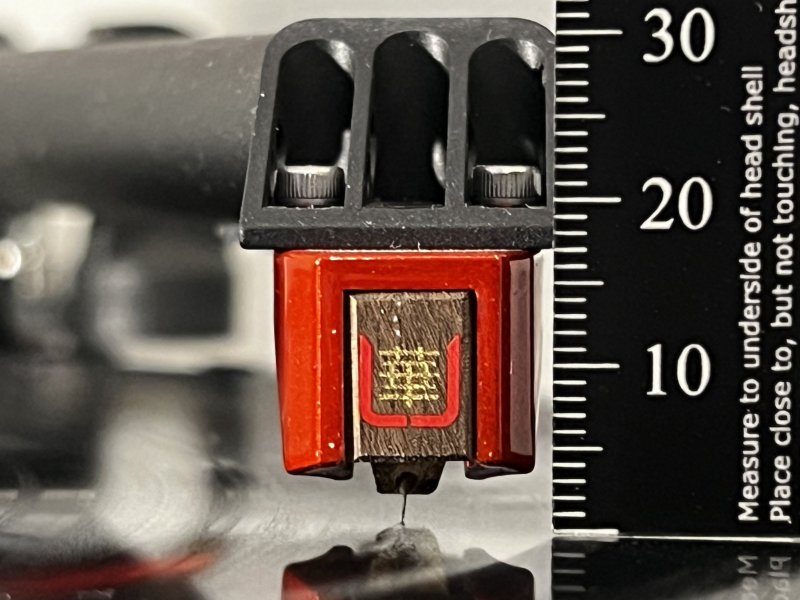
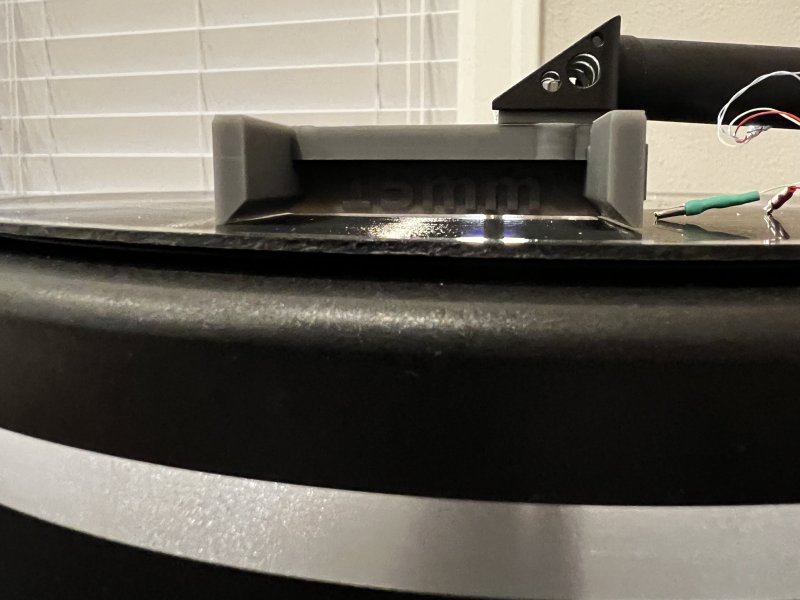
Today I got the dual-axis Wally reference and did more adjustments to the table.... I was shocked how much I had to lower my tonearm's pivot to get the headshell to be parallel with the disc (way more than I would ever dared to do just by "subjective listening"), and then I fine-tuned the azimuth until it was pretty parallel. It's pretty cool to have some objective way to do this regardless of whether the user agrees w/ JR's method or not.
If you watch JR's videos he talk about how many cartridge manufacturers raise SRA way above the optimal 92-deg. Personally I'm pretty stoked to get my cartridge back from JR's pre-mount service and see how different this sounds compared to my originally misaligned table!
Actually, the VTA is arguably more important than SRA (can't know yet as it's never been studied with any scientific rigor) and it is MUCH more defensible in terms of optimal playback target to hit.Keep us posted if/when you do this.
As someone who has /never/ done anything like this, I'd say the most decisive part is making the commitment to dive all in, or just say what you have is good enough. Personally I felt like I just invested quite a bit of $ in a new table, and it's now or never.
View attachment 131662
View attachment 131663
Today I got the dual-axis Wally reference and did more adjustments to the table.... I was shocked how much I had to lower my tonearm's pivot to get the headshell to be parallel with the disc (way more than I would ever dared to do just by "subjective listening"), and then I fine-tuned the azimuth until it was pretty parallel. It's pretty cool to have some objective way to do this regardless of whether the user agrees w/ JR's method or not.
If you watch JR's videos he talk about how many cartridge manufacturers raise SRA way above the optimal 92-deg. Personally I'm pretty stoked to get my cartridge back from JR's pre-mount service and see how different this sounds compared to my originally misaligned table!
Based upon your cartridge height, I can see we will be drawing down your VTA quite a lot! I have analyzed somewhere around 60-80 of those carts and yours is a bit tall, suggesting a steep cantilever assembly insertion angle.Keep us posted if/when you do this.
As someone who has /never/ done anything like this, I'd say the most decisive part is making the commitment to dive all in, or just say what you have is good enough. Personally I felt like I just invested quite a bit of $ in a new table, and it's now or never.
View attachment 131662
View attachment 131663
Today I got the dual-axis Wally reference and did more adjustments to the table.... I was shocked how much I had to lower my tonearm's pivot to get the headshell to be parallel with the disc (way more than I would ever dared to do just by "subjective listening"), and then I fine-tuned the azimuth until it was pretty parallel. It's pretty cool to have some objective way to do this regardless of whether the user agrees w/ JR's method or not.
If you watch JR's videos he talk about how many cartridge manufacturers raise SRA way above the optimal 92-deg. Personally I'm pretty stoked to get my cartridge back from JR's pre-mount service and see how different this sounds compared to my originally misaligned table!
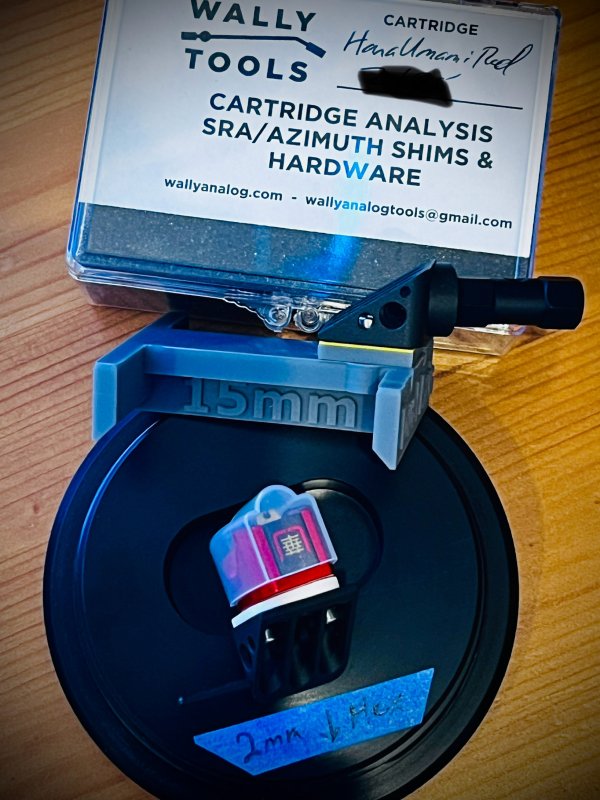
As a follow-up to my last post, I took advantage of WAMEngineering's Kuzma premount service and sent my cartridge to California for analysis. JR walked me through his very detailed report (how often do you need to watch a youtube video to understand an audio report??), and I received my cartridge custom shimmed in less than a 2 week turnaround (including shipping).
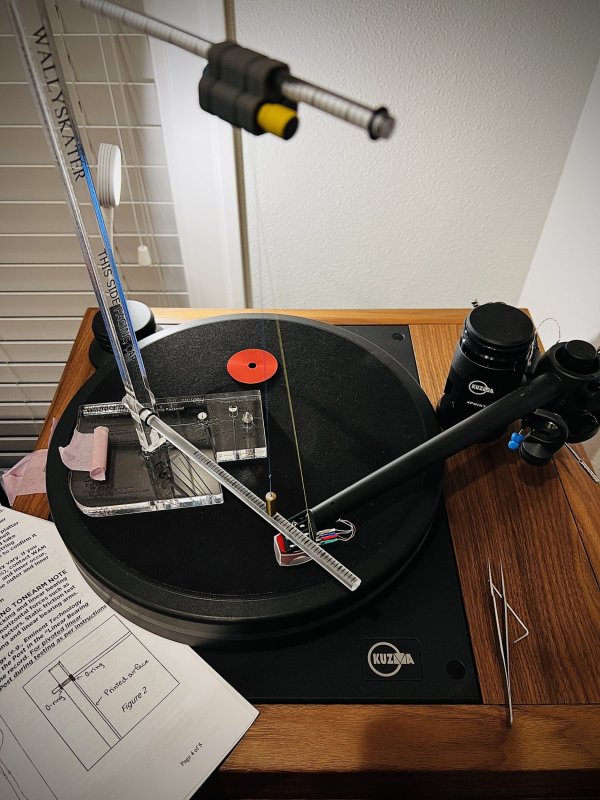
Finally, the Kuzma is set up! Using the WallyTools I was able to adjust the VTA with the shimmed Hana Umami, confirmed the anti-skate to 9% (also learned that BluTack worked better than the OEM Kuzma pulley weight!), and know that the table is objectively dialed in -- no more guessing! How cool is that?
Highly recommend folks check out WAM Engineering. Thanks JR!
BluTack worked better than the OEM Kuzma pulley weight!)
Very good -- I've used BluTack for a few years now. You can create a blob of it using a VTF scale for any weight you want. Franc Kuzma makes great stuff but his anti-skate weights can be too heavy for some situations.
Now that I'm finally into the weekend and not distracted by silly things like work, I can finally unpack the whole WAM service. JR included a little box w/ additional shims and a USB drive -- when I first started exploring this service I felt a little shy about the price, but I think these pictures of my cartridge from JR's analysis shows what you get for the price.... and if I could tell my 1-month ago self, it is an absolute bargain for this level of professional analysis and well worth it:

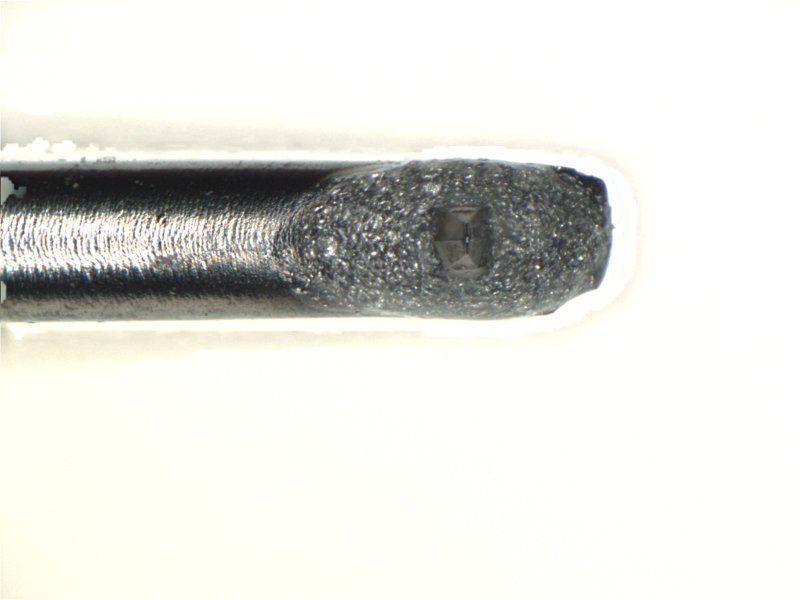


I mean.... shit, I paid more last year for my tax accountant's sloppy work (she mixed up my return w/ another client's)....




I mean.... shit, I paid more last year for my tax accountant's sloppy work (she mixed up my return w/ another client's)....
Have you listened yet? I noted a much more clean and intelligible playback. Well worth the investment. Eapecially for someone that wants to feel confident they have installed the cartridge very close to optimal. You can still dial by ear if you like. Only now you know how the cartridge was manufactured and where you should start.Now that I'm finally into the weekend and not distracted by silly things like work, I can finally unpack the whole WAM service. JR included a little box w/ additional shims and a USB drive -- when I first started exploring this service I felt a little shy about the price, but I think these pictures of my cartridge from JR's analysis shows what you get for the price.... and if I could tell my 1-month ago self, it is an absolute bargain for this level of professional analysis and well worth it:
View attachment 132383
View attachment 132384View attachment 132385View attachment 132386
I mean.... shit, I paid more last year for my tax accountant's sloppy work (she mixed up my return w/ another client's)....
I'm not sure if I post in the correct thread, but since it wasn't appropriate in this thread, I try here.
Please correct me if it's not.
I thought it may be interesting with a follow-up of VTA adjustment using a test LP.
All measurements are done with line contact stylus and a Kuzma 4Point tonearm. I have used both Lyra Atlas Lambda and AT33PTG/II.
Study of waveform of the vertically cut 1kHz sine on track B4 of UATLP. I measured with 0 VTA, -4.8mm VTA and +4.8mm VTA
This is a typical halfwave with different VTA:

(the above measurement is quite course because I was using a Fnirsi scope with quite low resolution. All measurements below are made with pcm 24/96)
This is an FFT of the signal:
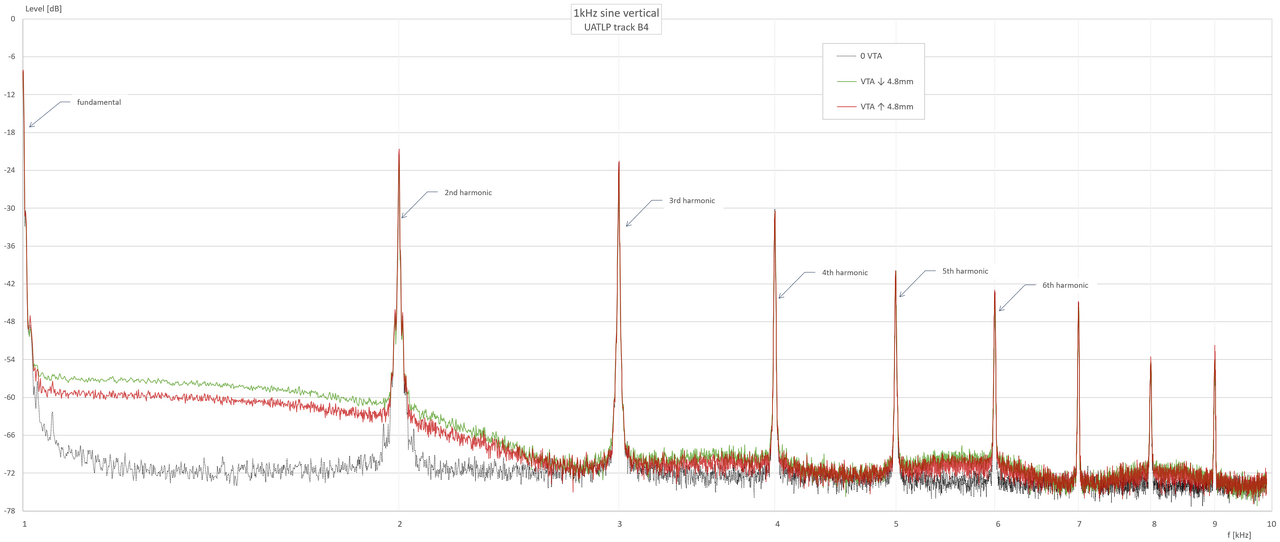
Close up of FFT for the fundamental and 2nd harmonic:
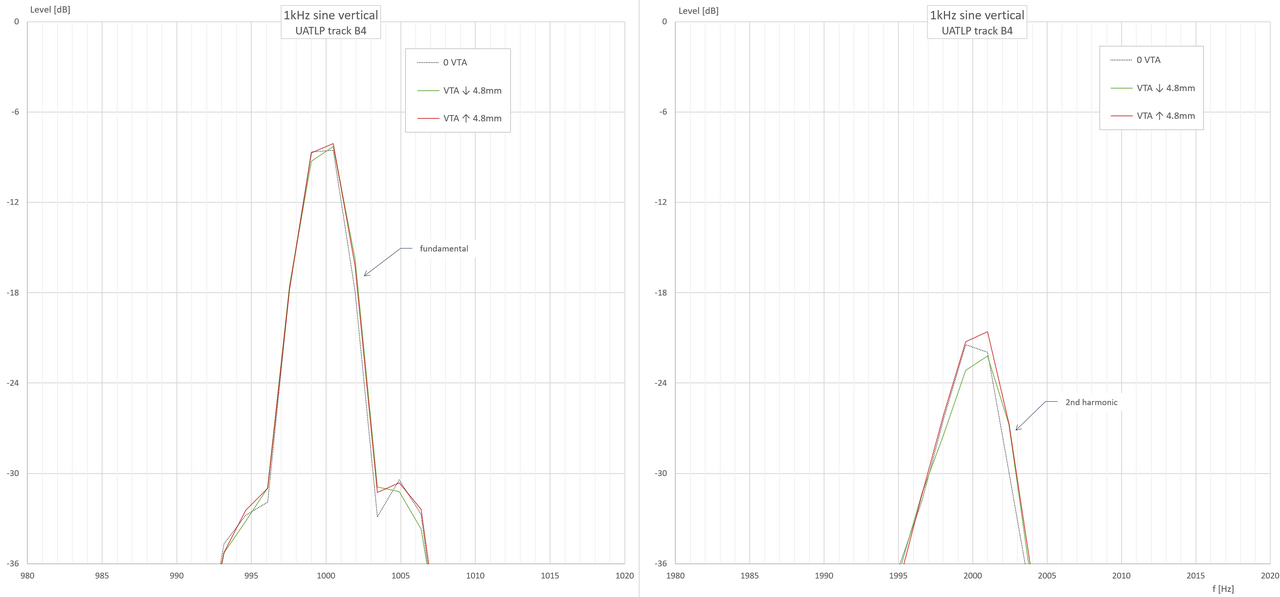
Study of 2nd harmonic of a vertically cut 1kHz square wave on track A1-4 of STR112. I measured with 0 VTA, -4.8mm VTA and +4.8mm VTA
FFT of the different settings of VTA:
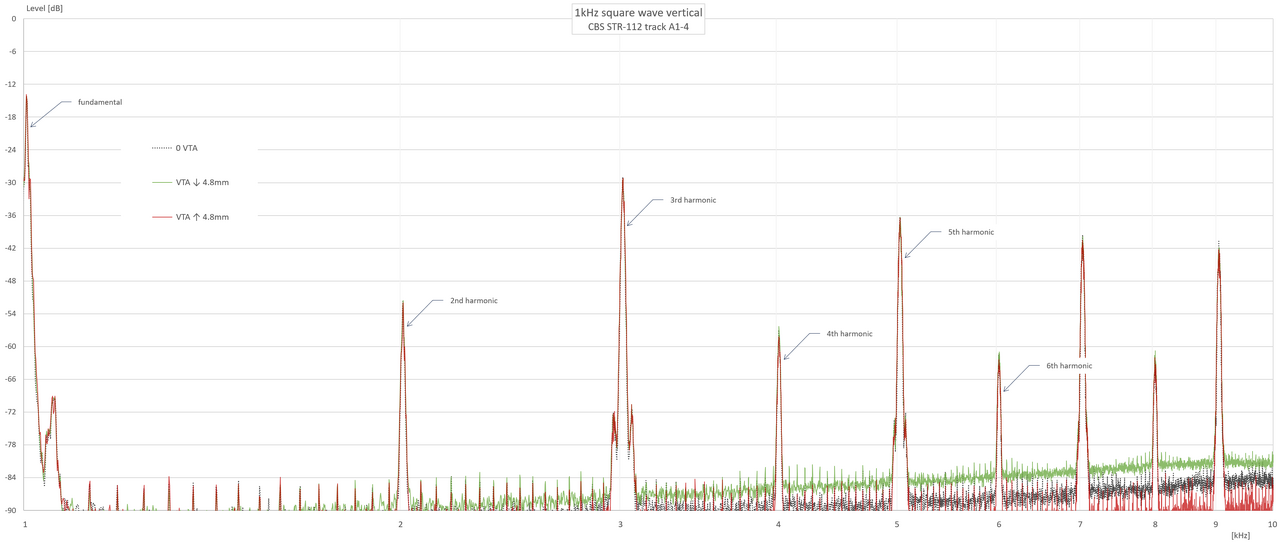
Closeup of fundamental:
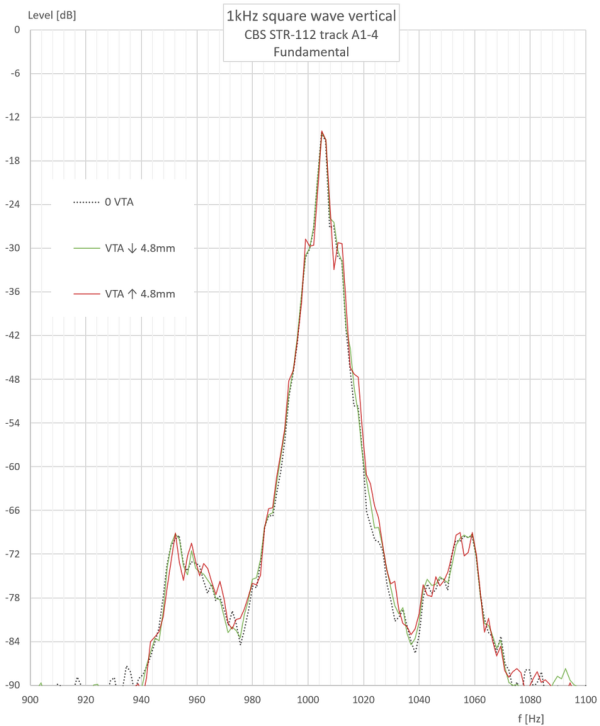
Closeup of harmonics:
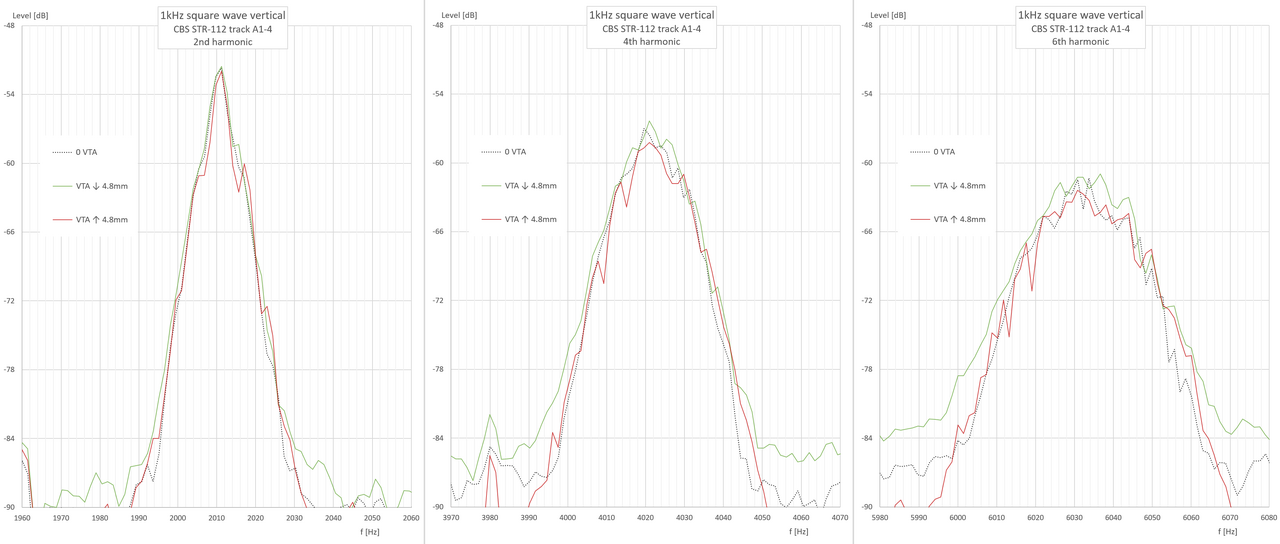
Study of the side lobes of 4kHz of the IMD track 60Hz + 4kHz 4:1 on track A9 of UATLP. I measured with 0 VTA, -4.8mm VTA and +4.8mm VTA
Sorry, I only have a screen shot of the FFT for the "0 VTA" setting:
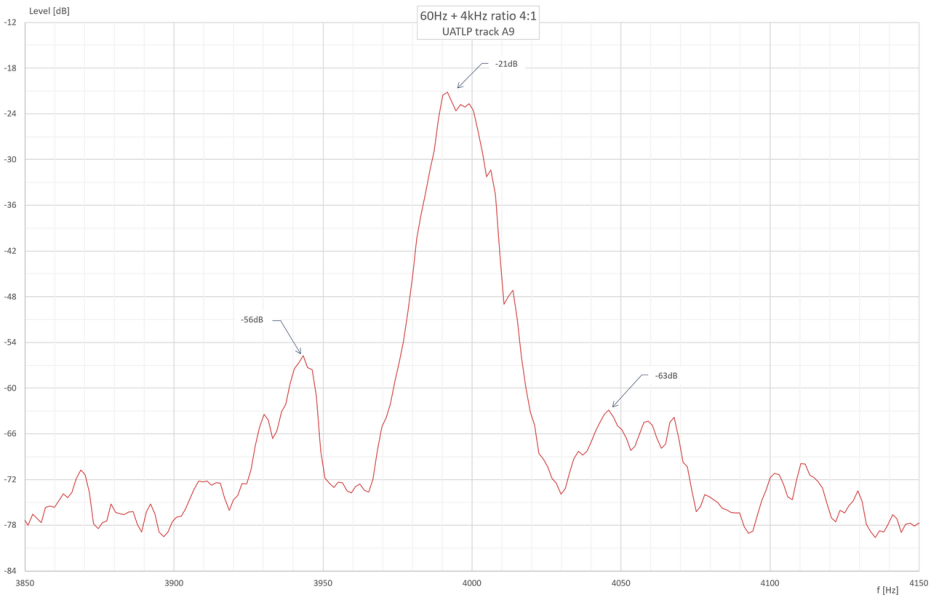
Conclusion
The above is just a few of the results. It's a bit time consuming to create all the graphics and I think you see the pattern.
I could not see any significant impact on the signal by changing the VTA quite substantially.
The different VTAs range about +/-1.5 degrees on an 11" arm. The changes are VERY visible by eye, but I think it's really not much in the groove even for a line contact stylus. I think 1.5 degrees error corresponds quite close to what is audible, about 0.7%THD.
Notes
- My experience is that changes in zenith and azimuth are MUCH more sensitive.
- I did not change the counterweight on the tonearm between the measurements. It means the VTF changes quite a lot due to different VTAs.
- UATLP = Ultimate Analogue Test LP
- STR112 = CBS STR-112
Please correct me if it's not.
I thought it may be interesting with a follow-up of VTA adjustment using a test LP.
I tried several methods and several test LPs. Some results from what should be most relevant below.You are on the right path. Keep going!
All measurements are done with line contact stylus and a Kuzma 4Point tonearm. I have used both Lyra Atlas Lambda and AT33PTG/II.
Study of waveform of the vertically cut 1kHz sine on track B4 of UATLP. I measured with 0 VTA, -4.8mm VTA and +4.8mm VTA
This is a typical halfwave with different VTA:

(the above measurement is quite course because I was using a Fnirsi scope with quite low resolution. All measurements below are made with pcm 24/96)
This is an FFT of the signal:

Close up of FFT for the fundamental and 2nd harmonic:

Study of 2nd harmonic of a vertically cut 1kHz square wave on track A1-4 of STR112. I measured with 0 VTA, -4.8mm VTA and +4.8mm VTA
FFT of the different settings of VTA:

Closeup of fundamental:

Closeup of harmonics:

Study of the side lobes of 4kHz of the IMD track 60Hz + 4kHz 4:1 on track A9 of UATLP. I measured with 0 VTA, -4.8mm VTA and +4.8mm VTA
Sorry, I only have a screen shot of the FFT for the "0 VTA" setting:

Conclusion
The above is just a few of the results. It's a bit time consuming to create all the graphics and I think you see the pattern.
I could not see any significant impact on the signal by changing the VTA quite substantially.
The different VTAs range about +/-1.5 degrees on an 11" arm. The changes are VERY visible by eye, but I think it's really not much in the groove even for a line contact stylus. I think 1.5 degrees error corresponds quite close to what is audible, about 0.7%THD.
Notes
- My experience is that changes in zenith and azimuth are MUCH more sensitive.
- I did not change the counterweight on the tonearm between the measurements. It means the VTF changes quite a lot due to different VTAs.
- UATLP = Ultimate Analogue Test LP
- STR112 = CBS STR-112
If you are simply raising/lowering the tonearm, you are changing MANY things at once with the most easily audible changes coming from changes in multiple vector forces. This is particularly true for the Kuzma 4Point design. This means your results are - at least - measuring the changes of at least seven parameters at once and very likely well over 10 parameters. This is why I make such a point of changing SRA and VTA at the headshell.I'm not sure if I post in the correct thread, but since it wasn't appropriate in this thread, I try here.
Please correct me if it's not.
I thought it may be interesting with a follow-up of VTA adjustment using a test LP.
I tried several methods and several test LPs. Some results from what should be most relevant below.
All measurements are done with line contact stylus and a Kuzma 4Point tonearm. I have used both Lyra Atlas Lambda and AT33PTG/II.
Study of waveform of the vertically cut 1kHz sine on track B4 of UATLP. I measured with 0 VTA, -4.8mm VTA and +4.8mm VTA
This is a typical halfwave with different VTA:
View attachment 133990
(the above measurement is quite course because I was using a Fnirsi scope with quite low resolution. All measurements below are made with pcm 24/96)
This is an FFT of the signal:
View attachment 133991
Close up of FFT for the fundamental and 2nd harmonic:
View attachment 133992
Study of 2nd harmonic of a vertically cut 1kHz square wave on track A1-4 of STR112. I measured with 0 VTA, -4.8mm VTA and +4.8mm VTA
FFT of the different settings of VTA:
View attachment 133993
Closeup of fundamental:
View attachment 133994
Closeup of harmonics:
View attachment 133995
Study of the side lobes of 4kHz of the IMD track 60Hz + 4kHz 4:1 on track A9 of UATLP. I measured with 0 VTA, -4.8mm VTA and +4.8mm VTA
Sorry, I only have a screen shot of the FFT for the "0 VTA" setting:
View attachment 133997
Conclusion
The above is just a few of the results. It's a bit time consuming to create all the graphics and I think you see the pattern.
I could not see any significant impact on the signal by changing the VTA quite substantially.
The different VTAs range about +/-1.5 degrees on an 11" arm. The changes are VERY visible by eye, but I think it's really not much in the groove even for a line contact stylus. I think 1.5 degrees error corresponds quite close to what is audible, about 0.7%THD.
Notes
- My experience is that changes in zenith and azimuth are MUCH more sensitive.
- I did not change the counterweight on the tonearm between the measurements. It means the VTF changes quite a lot due to different VTAs.
- UATLP = Ultimate Analogue Test LP
- STR112 = CBS STR-112
You are probably aware of this but the difference we are most sensitive to is the time domain, not frequency domain. It has been shown on multiple studies that at higher frequencies we can hear timing differences in the low microsecond range. If you want to see how things change when VTA is changed in isolation of other variables you have to get into Fourier analysis to see the details AND have the ability to change VTA without changing SRA. IMD measurements won't tell you enough.
Also, VTA is sensitive really only to vertically modulated grooves so you'll need either an out of phase signal or at least a single channel signal (less sensitivity, however) to do this analysis. The tracks you are using are all horizontally modulated so you won't see the effect of VTA changes. SRA, yes. VTA, no.
By the way, as I've said in my videos and seminars, that CBS STR112 has 3.4 degrees of cutting zenith error. That alone is quite a lot to drown out some of what we want to measure into the noise floor.
You are totally correct that zenith ERROR (no such thing as "zenith" in vinyl setup) and azimuth are much more sensitive on a degree for degree basis. I highly doubt we could hear less than 1 degree of SRA or VTA correction (ISOLATED, of course), but 1 degree of zenith error is obvious and so is it the case for azimuth.
You can start to see how complex it is going to be for us to study SRA in isolation of all other variables. We are in the process of collecting the right equipment for it already.
Thanks J.R, much appreciated reply.
But my intention is to find a method that guides me in the right direction anyway.
I'm aware I still need to iterate among the parameters.
Two of the three tracks I show above are vertically modulated. Track A1-4 on STR112 is 1kHz square wave vertical, track B4 och UATLP is 1kHz sine vertical, and track A9 on UATLP is 60Hz+4kHz ratio 4:1 lateral.
I found quite big differences in the cuts between two copies of the UATLP also. Less than half of that, but that track was on a nullpoint (track A5).
Even if there are issues with cutting errors or with changing SRA with VTA or other things; what puzzles me is why none of my measurements show any differences in either time or frequency domain.
Yes, I know. It is very difficult to isolate any of the parameters.If you are simply raising/lowering the tonearm, you are changing MANY things at once with the most easily audible changes coming from changes in multiple vector forces.
But my intention is to find a method that guides me in the right direction anyway.
I'm aware I still need to iterate among the parameters.
Hmm, I hear you and I see your point.have the ability to change VTA without changing SRA. IMD measurements won't tell you enough.
Two of the three tracks I show above are vertically modulated. Track A1-4 on STR112 is 1kHz square wave vertical, track B4 och UATLP is 1kHz sine vertical, and track A9 on UATLP is 60Hz+4kHz ratio 4:1 lateral.
I didn't know that. That's a big error.CBS STR112 has 3.4 degrees of cutting zenith error
I found quite big differences in the cuts between two copies of the UATLP also. Less than half of that, but that track was on a nullpoint (track A5).
Even if there are issues with cutting errors or with changing SRA with VTA or other things; what puzzles me is why none of my measurements show any differences in either time or frequency domain.
Really good to hear that!We are in the process of collecting the right equipment for it already.
Similar threads
- Replies
- 41
- Views
- 4K
- Replies
- 64
- Views
- 5K
- Replies
- 39
- Views
- 4K
Members online
- Rich J
- Salectric
- Pacha
- audioblazer
- Dezy
- ClarisysAudio
- Mike Lavigne
- tdx44
- Dierkx1
- Mark212121
- Koegz
- Tuckia
- theclipper
- hopkins
- Sharok
- Miramunt
- Zero000
- takacs75
- Republicoftexas69
- flowcharts
- marty
- Sarge
- bonzo75
- mtemur
- nonesup
- John T
- EuroDriver
- tony22
- HDVS
- 2ndLiner
- sbank
- Notdead
- Erikl
- jazdoc
- dminches
- Ackcheng
- Kid coconut
- Channel1.0
- jazzdude99
- rascs
- Mikeylee
- PrivateRacer
- DaveC
- austinpop
- Juiced
- Emorante
- oscarnr
- jadedavid
- itay123
- ationg
Total: 777 (members: 74, guests: 703)
| Steve Williams Site Founder | Site Owner | Administrator | Ron Resnick Site Co-Owner | Administrator | Julian (The Fixer) Website Build | Marketing Managersing |




